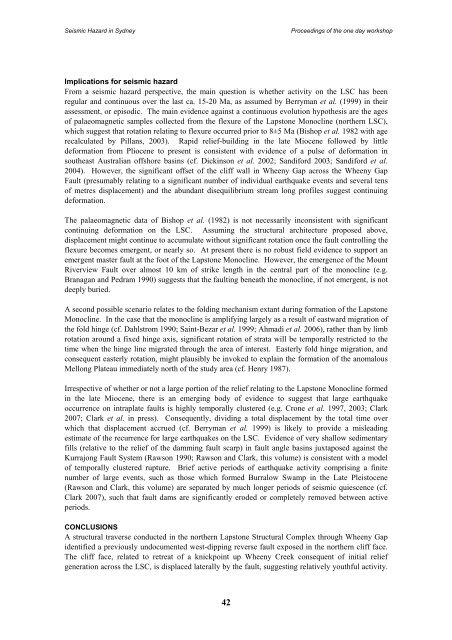Landslides in the Sydney Basin - Geoscience Australia
Landslides in the Sydney Basin - Geoscience Australia
Landslides in the Sydney Basin - Geoscience Australia
- No tags were found...
Create successful ePaper yourself
Turn your PDF publications into a flip-book with our unique Google optimized e-Paper software.
Seismic Hazard <strong>in</strong> <strong>Sydney</strong>Proceed<strong>in</strong>gs of <strong>the</strong> one day workshopImplications for seismic hazardFrom a seismic hazard perspective, <strong>the</strong> ma<strong>in</strong> question is whe<strong>the</strong>r activity on <strong>the</strong> LSC has beenregular and cont<strong>in</strong>uous over <strong>the</strong> last ca. 15-20 Ma, as assumed by Berryman et al. (1999) <strong>in</strong> <strong>the</strong>irassessment, or episodic. The ma<strong>in</strong> evidence aga<strong>in</strong>st a cont<strong>in</strong>uous evolution hypo<strong>the</strong>sis are <strong>the</strong> agesof palaeomagnetic samples collected from <strong>the</strong> flexure of <strong>the</strong> Lapstone Monocl<strong>in</strong>e (nor<strong>the</strong>rn LSC),which suggest that rotation relat<strong>in</strong>g to flexure occurred prior to 8±5 Ma (Bishop et al. 1982 with agerecalculated by Pillans, 2003). Rapid relief-build<strong>in</strong>g <strong>in</strong> <strong>the</strong> late Miocene followed by littledeformation from Pliocene to present is consistent with evidence of a pulse of deformation <strong>in</strong>sou<strong>the</strong>ast <strong>Australia</strong>n offshore bas<strong>in</strong>s (cf. Dick<strong>in</strong>son et al. 2002; Sandiford 2003; Sandiford et al.2004). However, <strong>the</strong> significant offset of <strong>the</strong> cliff wall <strong>in</strong> Wheeny Gap across <strong>the</strong> Wheeny GapFault (presumably relat<strong>in</strong>g to a significant number of <strong>in</strong>dividual earthquake events and several tensof metres displacement) and <strong>the</strong> abundant disequilibrium stream long profiles suggest cont<strong>in</strong>u<strong>in</strong>gdeformation.The palaeomagnetic data of Bishop et al. (1982) is not necessarily <strong>in</strong>consistent with significantcont<strong>in</strong>u<strong>in</strong>g deformation on <strong>the</strong> LSC. Assum<strong>in</strong>g <strong>the</strong> structural architecture proposed above,displacement might cont<strong>in</strong>ue to accumulate without significant rotation once <strong>the</strong> fault controll<strong>in</strong>g <strong>the</strong>flexure becomes emergent, or nearly so. At present <strong>the</strong>re is no robust field evidence to support anemergent master fault at <strong>the</strong> foot of <strong>the</strong> Lapstone Monocl<strong>in</strong>e. However, <strong>the</strong> emergence of <strong>the</strong> MountRiverview Fault over almost 10 km of strike length <strong>in</strong> <strong>the</strong> central part of <strong>the</strong> monocl<strong>in</strong>e (e.g.Branagan and Pedram 1990) suggests that <strong>the</strong> fault<strong>in</strong>g beneath <strong>the</strong> monocl<strong>in</strong>e, if not emergent, is notdeeply buried.A second possible scenario relates to <strong>the</strong> fold<strong>in</strong>g mechanism extant dur<strong>in</strong>g formation of <strong>the</strong> LapstoneMonocl<strong>in</strong>e. In <strong>the</strong> case that <strong>the</strong> monocl<strong>in</strong>e is amplify<strong>in</strong>g largely as a result of eastward migration of<strong>the</strong> fold h<strong>in</strong>ge (cf. Dahlstrom 1990; Sa<strong>in</strong>t-Bezar et al. 1999; Ahmadi et al. 2006), ra<strong>the</strong>r than by limbrotation around a fixed h<strong>in</strong>ge axis, significant rotation of strata will be temporally restricted to <strong>the</strong>time when <strong>the</strong> h<strong>in</strong>ge l<strong>in</strong>e migrated through <strong>the</strong> area of <strong>in</strong>terest. Easterly fold h<strong>in</strong>ge migration, andconsequent easterly rotation, might plausibly be <strong>in</strong>voked to expla<strong>in</strong> <strong>the</strong> formation of <strong>the</strong> anomalousMellong Plateau immediately north of <strong>the</strong> study area (cf. Henry 1987).Irrespective of whe<strong>the</strong>r or not a large portion of <strong>the</strong> relief relat<strong>in</strong>g to <strong>the</strong> Lapstone Monocl<strong>in</strong>e formed<strong>in</strong> <strong>the</strong> late Miocene, <strong>the</strong>re is an emerg<strong>in</strong>g body of evidence to suggest that large earthquakeoccurrence on <strong>in</strong>traplate faults is highly temporally clustered (e.g. Crone et al. 1997, 2003; Clark2007; Clark et al. <strong>in</strong> press). Consequently, divid<strong>in</strong>g a total displacement by <strong>the</strong> total time overwhich that displacement accrued (cf. Berryman et al. 1999) is likely to provide a mislead<strong>in</strong>gestimate of <strong>the</strong> recurrence for large earthquakes on <strong>the</strong> LSC. Evidence of very shallow sedimentaryfills (relative to <strong>the</strong> relief of <strong>the</strong> damm<strong>in</strong>g fault scarp) <strong>in</strong> fault angle bas<strong>in</strong>s juxtaposed aga<strong>in</strong>st <strong>the</strong>Kurrajong Fault System (Rawson 1990; Rawson and Clark, this volume) is consistent with a modelof temporally clustered rupture. Brief active periods of earthquake activity compris<strong>in</strong>g a f<strong>in</strong>itenumber of large events, such as those which formed Burralow Swamp <strong>in</strong> <strong>the</strong> Late Pleistocene(Rawson and Clark, this volume) are separated by much longer periods of seismic quiescence (cf.Clark 2007), such that fault dams are significantly eroded or completely removed between activeperiods.CONCLUSIONSA structural traverse conducted <strong>in</strong> <strong>the</strong> nor<strong>the</strong>rn Lapstone Structural Complex through Wheeny Gapidentified a previously undocumented west-dipp<strong>in</strong>g reverse fault exposed <strong>in</strong> <strong>the</strong> nor<strong>the</strong>rn cliff face.The cliff face, related to retreat of a knickpo<strong>in</strong>t up Wheeny Creek consequent of <strong>in</strong>itial reliefgeneration across <strong>the</strong> LSC, is displaced laterally by <strong>the</strong> fault, suggest<strong>in</strong>g relatively youthful activity.42
















